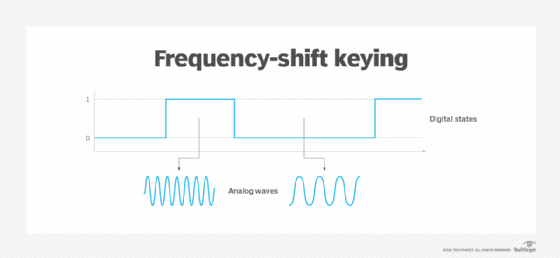frequency-shift keying (FSK)
What is frequency-shift keying (FSK)?
Frequency-shift keying (FSK) is a method of transmitting digital signals using discrete signals. The two binary states -- logic 0 (low) and 1 (high) in a binary frequency-shift key mechanism -- are each represented by an analog waveform.
Logic 0 is represented by a wave at a specific frequency, and logic 1 is represented by a wave at a different frequency. The distance between logic 0 and logic 1 is known as the deviation or shift point. A modem converts the binary data from a computer to FSK for transmission over telephone lines, cables, optical fiber or wireless media. The modem also converts incoming FSK signals to digital low and high states, which the computer can understand from a binary standpoint.
When transmitting data between nodes, the distance between the digital states dictates how much data can be transmitted within a specific length of time. Placing the logic 0 and logic 1 states too far apart will create slow throughput rates. However, if the frequency changes are too close together, it can create what is known as intersymbol interference (ISI) -- a condition which can cause errors on the receiving end of the connection. Thus, for maximum throughput and to prevent ISI, signals should be as close together as possible.

FSK can also operate using more than two binary discrete frequencies. These are known as multiple frequency-shift keying (MFSK). MFSK uses the M-ary orthogonal modulation technique that can transmit two or more bits simultaneously.
What is the history of FSK?
Frequency-shift keying has a relatively long history. It was first invented for use with mechanical teleprinters in the mid-1900s. The standard speed of those machines was 45 baud, which is equivalent to about 45 bits per second. When PCs became common and networks came into being, this signaling speed was tedious at these throughput rates. The transmission of large text documents and programs took hours to complete. During the 1970s, engineers began to develop modems that ran at faster speeds, and the quest for ever-greater bandwidth continues. Early computer modems used FSK up to the point where 1,200 baud rates were achieved. Additionally, second-generation cellular technologies used FSK for call signaling purposes. Once bandwidth requirements reach a certain rate, however, FSK is considered inefficient. Thus, other digital modulation mechanisms are often used in place of FSK.
FSK has also contributed to other digital transport innovations, leading to several spectrum modulation variants, including:
- Minimum-shift keying, which is used to convert a digital signal into analog signals.
- Gaussian minimum-shift keying, which is a constant-envelope type of modulation.
- Audio frequency-shift keying, which is a modulation technique that represents digital data.
- Continuous-phase frequency-shift keying, which is a continuous form of analog frequency modulation.
What are the applications for FSK?
Despite its bandwidth limitations, FSK is still used today in certain situations where high-reliability transport is needed for low-bandwidth applications. Common use cases for FSK or close variants include:
- paging communication systems;
- caller identification; and
- utility metering.
What is FSK being replaced by?
For applications and use cases that require higher throughput rates, FSK has largely been replaced by other digital modulation techniques such as:
- Amplitude-shift keying (ASK), which uses shifts in amplitude to correspond to bit values.
- Phase-shift keying (PSK), which depicts bit values as changes in angle modulation.
- Quadrature amplitude modulation, which is a combination of ASK and PSK that is designed to handle even higher data transmission rates.
How do 802.11ac and the newest Wi-Fi standard, 802.11ax, differ? Learn the differences between Wi-Fi 5 and Wi-Fi 6.







